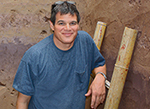From the American workplace to the Chinese countryside, Washington University in St. Louis researchers collected and analyzed important data to better understand our ourselves and our world. Among the discoveries this year, School of Medicine researchers found parents who have children with autism have more autistic traits themselves, while experts in the Department of Psychology in Arts & Sciences found the personality of our spouse can influence our own job satisfaction.
Here are the top 10 most-read Washington University Newsroom research stories generated from the field in 2014:
1. Exploring health benefits of fasting two days a week
School of Medicine researchers studied whether fasting a few days a week provided some of the same health benefits as severely limiting calories every day of the week.
2. Want to kill creativity of women in teams? Fire up the competition
Women tend to outperform men when it comes to collaboration and creativity in small working groups, but force teams to compete head to head and those roles are soon reversed, an Olin Business School study found.
3. Spouse’s personality influences career success, study finds
As much as we might try to leave personal lives at home, the personality traits of a spouse have a way of following us into the workplace. Psychology researchers found a spouse’s personality influences promotions, salaries and job satisfaction.

4. Humans have been changing Chinese environment for 3,000 years
A widespread pattern of human-caused environmental degradation and related flood-mitigation efforts began changing the natural flow of China’s Yellow River nearly 3,000 years ago, setting the stage for massive floods that toppled the Western Han Dynasty. The research was from the Department of Anthropology in Arts & Sciences.
5. Splints favored for kids’ forearm buckle fractures
When children fall and try to catch themselves with an outstretched hand, they suffer “buckle fractures,” forearm injuries traditionally treated with casts. But School of Medicine research showed that removable splints are preferred by patients and parents.
6. Hope for those with social anxiety disorder: You may already be someone’s best friend
Making friends is often extremely difficult for people with social anxiety disorder and, to make matters worse, people with this disorder tend to assume that the friendships they do have are not of the highest quality. The problem with this perception, psychology research suggested, is that their friends don’t necessarily see it that way.
7. Autistic traits seen in parents of kids with autism
When a child has autism, his or her parents are more likely to have autistic traits than parents who don’t have a child with an autism spectrum disorder, School of Medicine researchers found.
8. Alcohol, tobacco, drug use far higher in severely mentally ill
Researchers at the School of Medicine and the University of Southern California found that rates of smoking, drinking and drug use were significantly higher among those who have psychotic disorders than in the general population.

9. Himalayan Viagra fuels caterpillar fungus gold rush
Anthropology researchers made an interesting discovery in Tibet: Overwhelmed by speculators trying to cash-in on a prized medicinal fungus known as Himalayan Viagra, two isolated Tibetan communities managed to do at the local level, what world leaders often fail to do on a global scale — implement a successful system for the sustainable harvest of a precious natural resource.
10. Free birth control doesn’t promote risky sexual behavior in women
Researchers at the School of Medicine showed that providing women with free contraception did not increase the likelihood that they will have sex with multiple partners.
Want more: Read the most-read stories of 2014: In the laboratory and
In the classroom and in the community.